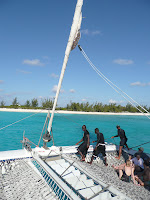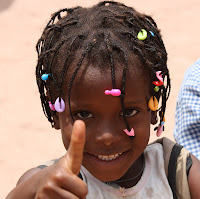 After a calm Atlantic crossing from West Africa, we reached our first Caribbean port of Barbados. We were looking forward to taking to the azure waters and were not disappointed, first snorkeling with turtles who swam like flat bottomed submarines towards us, brushing against us in search of food. Admittedly, we outnumbered the turtles, but later on that afternoon we relaxed in the tranquility of the pristine water. Lying on our backs, the salty water kept us buoyed. The sky was hanging with cumulus clouds and the lush vegetation beyond the beach was alive with the chatter of birds. Magic.
After a calm Atlantic crossing from West Africa, we reached our first Caribbean port of Barbados. We were looking forward to taking to the azure waters and were not disappointed, first snorkeling with turtles who swam like flat bottomed submarines towards us, brushing against us in search of food. Admittedly, we outnumbered the turtles, but later on that afternoon we relaxed in the tranquility of the pristine water. Lying on our backs, the salty water kept us buoyed. The sky was hanging with cumulus clouds and the lush vegetation beyond the beach was alive with the chatter of birds. Magic.The following day we sailed past Guadeloupe, its headlands dotted with a chorus line of wind turbines. It was early morning, our usual walk on deck underway. On the opposite side of the ship there was a sudden splash in the water. Often when a wave crests you hope it is a creature from below breaking the surface. In most cases it isn't but today we were all delighted to see a humpback whale flash its tail above the waves then dive back down to resurface a few minutes later.
ANTIGUA
Docking in Antigua was a bit of a surprise - the busy shoreside now dotted with duty free shops hawking Columbian emeralds and Island rum bore no resemblance to the place we remembered on our last visit - but that was 20 years ago. No matter, today we were going to the rain forest to zip line over the exotic forest canopy.
After a bumpy ride through the countryside we reached our destination. Eventually - we were most definitely on Island time - we were kitted out in harnesses, carabenas, ropes, helmets and gloves. And then we proceeded across a rickety suspension bridge to the first jumping off point.
This was one of nine such zips.
It was hot, we sweated profusely, but we loved every minute. Except of course for the final maneuver which involved walking off "the leap of faith" platform to free-fall into a 25 foot drop to someone below who didn't really seem to be very motivated to make sure we landed safely.
This I thought would likely void our waivers, the language of which was interesting ....
I am however here to tell the tale, pictures in hand and somewhat gratified to know that our next stop will be in Tortola - the hunting ground of Captain Jack Sparrow. But instead of jumping off platforms into rainforest, we will be leaping into the ocean from a catamaran - can't wait.
TORTOLA
The reading materials describe the British Virgin Islands as serene, seductive and spectacularly beautiful. Sailing in on Sunday morning the views on all sides of the ship lived up to their billing. The numerous islands that make up the chain - Tortola being the largest - are striking with steep green hills.
We boarded our catamaran and within minutes the trade winds had picked up the sails and we were off to our destination about 45 minutes away. We sat with our legs dangling off the cat, the soles of our feet occasionally kissed by the waves. The ocean, which reflected the sun, had a platinum look to it.
Our snorkeling destination for the morning was a feast for the eyes. Turquoise water lapped against a rocky enclave.
The fish swam amongst us as though we were invisible - colourful sylph-like creatures striped with yellow, silver, purple and blue. We motored on to our beach destination, continuing our new-found pastime of simply floating on our backs in the warm, salty water.
TURKS AND CAICOS
Today we set off on another catamaran trip to snorkel. We reached a coral reef which fell away sharply into deeper water, providing a dramatic contrast in colour as we splashed about. The most common fish, yellow fin snaps, their silver bodies and bright yellow markings appeared luminescent as they darted about, framed against the deep blue water beyond the reef.

The colour palate was perfect. Later that afternoon under full sail we docked at a sandy beach to swim. Its hard to explain the thrill of walking down the catamaran's narrow ladder into the ocean. It was as though we were stepping into an underwater screensaver with a sparkling emerald and azure backdrop.
I told our companions that we have water this colour in British Columbia - the only problem is it is glacial. Pondering that thought, we continued to float in the water as it lapped over our bodies.






























